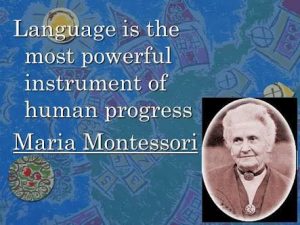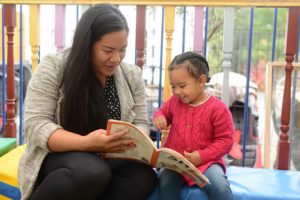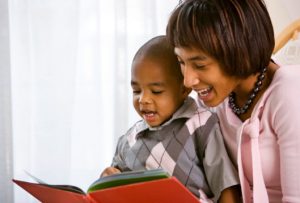By Julia Gorham
Oral Language is the child’s first, most important, and most frequently used structured medium of communication
It is the primary means through which each individual child will be enabled to structure, to evaluate, to describe and to control his/her experience.
In addition, and most significantly, oral language is the primary mediator of culture, the way in which children locate themselves in the world, and define themselves with it and within it” At its most basic level, oral language is about communicating with other people.
It involves a process of utilizing thinking, knowledge and skills in order to speak and listen effectively. As such, it is central to the lives of all people.
Oral language permeates every facet of the school curriculum. The development of oral language is given an importance as great as that of reading and writing, at every level, in the curriculum.
Five Components of Effective Oral Language Instruction Create a Language Learning Environment Develop Listening & Speaking skills
Below is an article which relates to these 5 elements for effective language instruction and which contains useful information regarding the skills of speaking and listening. The early years are a period in which young children are using language to learn not only about their world but also how language can be used to serve many purposes.
- To a certain degree, children pick up this knowledge naturally, but an astute teacher or parent plays a vital role in assisting children in their ability to be good conversationalists. Conversing with children is not the only way to increase vocabulary, however.
- Strategies teachers use while reading with and to children can also build their word banks. Asking open ended questions (questions in which there is no right or wrong answer and to which the adult does not “know” the answer) helps teachers assess children’s comprehension but also helps them learn more vocabulary words (Whitehurst et al., 1988, as cited in Wasik, 2006)Kerry (1982) asserts that the vast majority (approximately 80%) of “teacher talk” in classrooms is focused on tasks: giving instructions, providing information, or correcting behaviour or information.
- Of this talk, 80% of it consists of low-level questions that ask children to recall information rather than open-ended questions requiring children to think at higher levels (as cited in Jalongo, 2008).
- Conversing with children is not the only way to increase vocabulary, however. Strategies teachers use while reading with and to children can also build their word banks.
- Asking open ended questions (questions in which there is no right or wrong answer and to which the adult does not “know” the answer) helps teachers assess children’s comprehension but also helps them learn more vocabulary words
- A very important consideration in using any questioning technique is the “wait time” given to children as they formulate their response. In addition to giving children ample time to formulate answers, how teachers respond at that point can encourage or discourage future participation in discussions.
- Attentive body language, expanding children’s responses, asking clarifying questions, and using reflective listening techniques are ways to support children’s continued participation in current and future dialogues (Otto, 2006). The obvious partner to participating in talk is the ability to listen.
- Conversation is a two way communication experience. Although children’s oral, or expressive, language often gets emphasized, receptive language, or listening, is equally important. Naturally, the ability to listen is also a key component in learning.
It is the way children take in information through ways of helping children participate as listeners and speakers in conversations is for teachers to model good listening and speaking techniques themselves.
The Following are some things teachers can do to increase children’s listening and speaking
- When children are speaking, get down to their eye level. It is difficult to keep up a conversation with someone when you must keep looking up.
. • Treat children as if they are skilled at conversation. Give them your full attention and focus on what they say. Ask open-ended questions to follow up on what they share.
- Speak to all children, even those who may have language delays or who are English language learners.
- Ask children questions about things to which you do not know the answer. Questions that ask children to reflect on a topic or to formulate opinions and explain them not only show children that you value their ideas but also encourage them to think about their own feelings and ideas. Don’t give up if children don’t respond well the first time. Sometimes this kind of questioning and responding takes more deliberate probing and time for children to develop this skill.
- Help children learn to listen to one another. When adults value listening to children and to each other, children will notice this. Adults must also, however, be intentional in giving children the skills to listen to one another. Some teachers find that giving the speaker a prop, such as a stuffed animal or other small object, while speaking to the group helps distinguish whose turn it is to talk.
- Limit group time and small group discussions to a reasonable time limit for young children. Their ability to stay attuned to a lengthy discussion is incomplete at this age. When attention is wandering, it is best to bring closure to the activity and transition to something else. Record, both by writing on chart paper and audio, transcripts of discussions so that children can hear and have read back to them things that were shared.
- Value all the home languages of the children in the class, including sign language for the hearing impaired.
- For the benefit of English language learners and everyone else, learn some of the key words and phrases in the languages represented in the group, record them, create word/picture cards, and provide them in a listening centre. This way, children can learn some important words in another language and support the speaker of that language (Jalongo, 2008).
- Help children learn to listen and to ask questions by having “Show and Ask” rather than “Show and Tell.”
What needs to be taught? There are certain elements that need to be explicitly taught before embarking on formal instruction of oral language.
These are;
- Awareness of broad rules that govern social interaction
- Non-verbal behaviours
- Rules for listening
- Rules for speaking
Awareness of broad rules that govern social interaction: In order to teach speaking and listening skills, teachers will need to create awareness of the way conversation works by considering the “rules” to be observed by good speakers and listeners. These are often unconscious.
Turn Taking: Turn taking is very important for an effective speaker listener relationship. Students need to recognize pauses in a conversation where they can take a turn, interrupt, ask a question or change the subject. Teachers can explicitly teach turn taking so that all pupils are encouraged to speak e.g. circle time where everybody has a turn, asking students to work with a partner and choose who will go first.
The Floor: the person who is currently speaking is the person who “holds the floor”. During conversations, speakers and listeners use eye contact, body language, gestures, and pauses to judge when a new voice can take the floor.
Adjacency Pairs: these are the sequences of two utterances next to each other, produced by two different speakers e.g. a question and an answer, a greeting and a response. This can work well to help develop the everyday social interactions of pupils.
Repair: repair takes place when a speaker has to “fix” something they have said e.g. “I said seen, I meant saw”. Sometimes the listener can seek a repair which could be expressed through a facial expression or body language or check for meaning by asking a question such as “What do you mean? ” or “I don’t understand”. Pupils need to be encouraged to check that they understand what another person is saying and to check that others understand them.
Non-verbal behaviours. Communicating is more than just words. The manner in which we use voice, facial expression, and body language affects the messages we are trying.
Students are not always aware that their posture or the way they approach another person speaks volumes in itself. By creating awareness around the expressive nature of the way a person uses their body and voice, teachers can help pupils to become critically aware of the non-verbal behaviours that will equip them to express themselves in an effective manner.
What are these non-verbal behaviours?
- Use of voice: The use of intonation and pauses that convey meaning and attitude.
- Volume: Volume depends on the needs of the situation, purpose and audience. There are times when loud voices are required such as in a play, or during assembly. There are also times when quiet voices are necessary such as working in the library. Generally speaking a voice should be loud enough that the intended audience can hear and understand the message being delivered. The use of varying volume will help to create emphasis or drama when recounting events, telling a story or persuading an audience.
- Intonation: Intonation indicates the changes in speech; a downward intonation indicates that a message is complete, while an upward intonation indicates a question.
- Pitch: Pitch is useful to use when expressing emotion. Our pitch rises when we are excited and lowers when we are sad.
- Pauses: Pauses are moments of silence between phrases, used to separate ideas and also used for holding attention. This is particularly useful when giving formal presentations such as an oral report or telling a story
- Pronunciation: Pronunciation refers to the way words are said. Some younger pupils may have difficulty in pronouncing the sounds in some words and will benefit from hearing those words modelled in meaningful contexts. Pronunciation varies across regions. It is important that pupils know the accepted pronunciation of words in Standard English.
- Proximity: Proximity is the amount of personal space between people who are talking. The relationship between them, their personalities, and their culture or whether the situation is personal, social or public will all affect the amount of proximity needed.
- Eye contact: Eye contact is the use of the eyes or gaze in face to face communication. The level of eye contact often depends on the relationship between the communicators and affects both the speaker and the listener. (Developing Listening Skills: According to LeLoup and Pontero)
“Listening is arguably the most important skill used for obtaining comprehensible input in one’s first language and in any subsequent languages. It is a pervasive communicative event. We listen considerably more than we read, write or speak.”
In order to teach listening skills teachers need to:
- Explicitly model how to be good listeners
- Show the children footage of what good listening looks like
- Schedule quiet, listening opportunities as part of the school day
- Provide spaces in the classroom that encourage conversation and attentive listening, e.g. ‘The shop’, ‘The doctor’s surgery’
- Create organic learning charts to capture what good
Activities to develop speaking and listening skills:
- Act It Out This is a small group activity designed to give pupils time to decide what they would do in different situations. It provides them with the opportunity to discuss the information they need to include and to try to find ways of improving their speaking and listening.
At the table pick a scenario card and discuss these questions, what is happening? How do we know? What will we say and do so that everybody knows what we mean? How can we say this so that it sounds like the talk we use in school? What will we do to show that we understand what is being said?
You need to decide who will act out the part and where the action will start, before, during or after the event on the card.
Try acting it out. Students can then reflect on these questions, what made sense and why? where else could we listen like this?, where else could we speak like this? What would we say differently next time and why?
It is important that the classroom environment is supportive and nurturing where a variety of communication styles are valued, accepted and accommodated. Teachers can design differentiated teaching and learning activities that draw on pupil’s interests, knowledge and skills. Teachers will also support students by helping them to develop strategies to use when speaking and listening for different contexts. By providing authentic purposes and audiences for speaking and listening, pupils will become confident and enthusiastic communicators.
Ways of developing the classroom culture:
- Create a classroom culture of “have a go”
- Be sensitive to cultural differences
- Emphasise enjoyment for all
- Value social talk and the use of language used in the home
- Seize the moment if something unusual in the school happens or if a child brings something to school
- Encourage all attempts by the children at both speaking and listening
- Teach pupils to share classroom responsibilities e.g. change the calendar, set up writing table, organize the library
- Maintain an emphasis on enjoyment
- Provide opportunities for the children to reflect and review their speaking and/or listening
- Explicitly teach students to take turns in groups
- Communicate high expectations
- Motivate pupils to speak with all members of the class
Ways of developing opportunities for discussion
Model good listening to the children
- Model using specific language to the children e.g. re-telling stories
- Provide role play opportunities to experiment with language
- Teach/display nursery rhymes, poems, songs, chants, raps so that children can hear and practice the structure and sounds
- Read aloud to the children every day
- Provide puppets, felt boards, toys to re-tell favourite stories
- Read a variety of text types to the children
- Model and allow the children to purposefully
- Teach pupils to resolve conflicts through language e.g. “The next time you should say” , “I would like to play with that ball when you have finished please”
The pupils listen to each direction and does at it says only if they hear their numbers following the direction.
- Clap your hands
- Say the name of your best friend
- Stand up
- Touch your nose
- Say the name of your favourite sweet
- Walk to the door and back etc.
Teacher reads some sentences twice. On the second reading the teacher leaves out one word. The pupils must re-call the missing word. It may be useful for the teacher to underline the left out word for the second reading – Sean and Dana are twins. They look so much alike that your cannot tell one from the other
Teacher reads a group of words. The pupils listen and then carefully tell the teacher the beginning sound of each word. Then the teacher changes it to the last letter in each word – Say, see, sell – Game, girl, good – Pear, poor, pond – Ring, read, rain – Two, tin, teeth, – Bag, bead, bike
Teacher asks some questions. The pupils must think of more than one answer to the question – What could you find growing in a forest? – What could you find living in a zoo? – What could you find in a grocery store? – What could you find in an animal
Teacher reads a series of short stories, perhaps 4-5. Pupils listen very carefully as questions will be asked after each story.
Ask questions that only have numbers as their answers. Pupils respond by restating each question in the form of a statement that includes the answer e.g. “how many tusks does an elephant have” “an elephant has two tusks” – How many paws does a dog have? – How many legs are there on a three legged stool? – How many openings does a fish bowl have?
Developing Oral Language with your child Tips for Parents /Guardian
- Listen to what your child is saying /trying to say and respond to contributions
- Make and maintain eye contact while talking with your child
- Explain the meaning of words
- Talk through activities
- Talk through everyday experiences
- Involve your child in discussions / plans
- Ask / Answer questions
- Teach your child nursery rhymes / songs / poems/ raps
- Develop your child’s receptive language by asking him/her to follow simple instructions
- Assist your child to express ideas in an orderly fluent way
- Read to your child each night
- Set aside 10-15 minutes to discuss the day’s happenings
- Encourage your child to express and justify opinions
- Involve your child in adult conversation when appropriate
- Talk about the child’s favourite T.V programme
- Play language games which focus on words i.e. Scrabble, crosswords
- Encourage your child to talk about experiences with a wide range of people ; peers, relations, other adults
- Listen carefully and clarify meaning ‘Do you mean /or is this what you mean?’
- Encourage your child to give reasons for decisions
- Encourage your child to listen courteously to the opinions of others
- Talk about school topics
- Encourage your child to develop a positive attitude to speaking / listening
- Discuss your child’s school work successes/concerns/interests
- Respect your child’s opinions and feelings
- Involve your child in adult conversations, when appropriate
- Help your child to extend his range of words in specialised subjects
- Encourage your child to listen and respond courteously to others.










